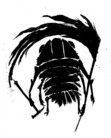Patrick Stuart's Blog
October 7, 2025
A review of The Golden Peaches of Samarkand
tldr; this book has a whole sub-section on Dwarfs
Its 1962 and Edward H Schafer delves into ream upon uncounted ream of scholarship and records, all to make a list. Lists, beloved by RPG nerds, chroniclers, romantic writers and a Billy Joel.
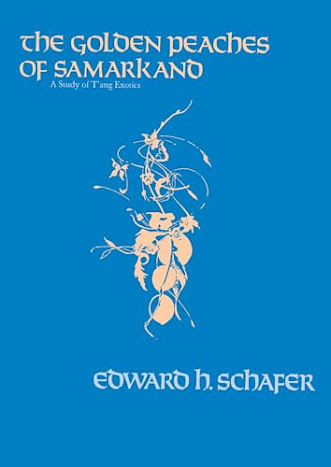
If reams of DnD theory have been ejaculated from the question ‘What do they have in their pockets?’, birthing engines of devisment dedicated to the rapid simulation of a goblins pockets, and thence, by inference at least, also making query; what can we learn of Goblin culture from the contents of one Goblins pockets? Here now, are the pockets of a People, or an Empire, or at least a Dynasty; one of the big ones, the T’ang. Her is an encyclopaedia of all that the Emperor received. This shows us several thing;
First, it is an image of the world as perceived by the T’ang court. At its distant, wildest most suggestive western reaches, it brushes against ‘Rum’, but the more common Occidental foreigner is the ever-wealthy Persian, bringer of materials and artistic styles. To the East we hear of jungle islands, home of rare hardwoods, poisoned arrows and magical pearls. In the ocean lie the phosphorescent eyes of whales. To the South West is India; source of scripture, and of suspicious witchy alchemists who probably accidentally poisoned the Emperor that one time. South lies the known, but uncivilised aboriginal lands of continental China, malarial yet wealthy country. To the north, the ever-dangerous and very charismatic horse-riding barbarians; one Chinese noble larps so hard as a northern barbarian he ends up living in a tent erected on his family estate, wearing furs, drinking milk and eating near-raw meat, dreaming of the steppe
Second; it is an image of China and Chinese tastes and culture, as seen from the very peak of the pyramid. Horses are desired. The Middle Kingdom has a massive thirst for Horse and is always drinking dry its own supplies. A centrally-mandated Horse-sustainment organisation exists, with vast government herds, but they never seem to have enough and tribute in horses is ever-desired. Some treasures have cross-cultural appeal; hawks, dwarfs and slave girls might be banned occasionally but the tribute always starts up again. One wise magistrate is honoured by his land; he elegantly evades the relentless Imperial demands for MORE DWARFS, taken from his small population, by claiming that since everyone in his country is very small, and they are all pretty much the same height, he really can’t choose anyone exceptional to be sent to the Imperial Court. Another wise one saves the nature pearl-farms by instituting fierce governmental controls, later he is deified as one who returns the pearls. Its only about 800ad but the environmental devastation and consumption of a massive civilised population is already a stark part of the story. China needs horses, but despite efforts, can’t maintain them. She loves pearls, but over-fishes them. The exotic creatures from the borders of her lands keep going extinct or disappearing. This land is like a great terrible octopus, devouring whatever its can from the edges of its knowledge, but ever-spreading.
Third; it paints a suggestive and utterly deranged picture of what life might actually be like in the Imperial Palace; gilded squalor comes to mind. Wealth incalculable, chaos unending. The throne must have tribute and that tribute can come in many, almost in any, form. This means the Palace is filled with, is crammed with, whole zoo’s and parks of rare and strange animals, often the only ones of their kind. Horses, camels, cattle, sheep and goats, asses, mules onagers, dogs, elephants, rhinoceroses, lions, leopards, cheetahs, sable, ermine, gazelles, marmots, mongeese, weasels, ferrets, hawks, falcons, peacocks, parrots, ostriches and several animals, the ‘Doubtful Ungulates’ or ‘Doubtful Carnivores’, whose name and nature is unclear. These creatures may be mythic, or extinct.
That’s just the animals. If a foreign king sends the Emperor, for instance, an instrument, he will send the musician to play it, in fact, the whole band, actually send the orchestra, the dancers, backstage people, everything. Its not a holiday, they belong to the Emperor now. The palace holds entire third generation micro-communities descended specifically from such ‘gifts’. Throw in prisoners, slaves, (Dwarfs of course), Hostages (the heirs to foreign kingdoms might end up joining one of several ritual palace guard companies), or other skilled workers in materials and crafts.
We haven’t even gotten to the objects. For all the animals, imagine at least ten times the variety of plants, sent to wither or bloom in strange soil, then woods, foods, aromatics, skins, drugs, textiles, pigments, industrial materials, jewels, metals, weapons, lamps, books and sacred texts and yes of course when an Indian king sends a sacred Buddhist text in Sanskrit, he also sends along a sage who will spend the entirety of his life in the T’ang court, translating this One Book into Chinese, in one case with the Empress Wu hanging out directly over his shoulder (she liked to watch him do it).
Those are just the generalities, you must imagine, hidden and skittering amidst these grand illusions of systemic knowledge, just a bunch of weird random shit; a solid gold wine jug in the shape of a great goose, a 100 foot iron pillar holding at its top a ‘fire orb’ carved with the names of the Empress and her greatest Advisors. Asbestos robes.
Magic has no meaning here because everything is a bit magic by western standards. Nothing is ever just material. Amber, born from the coagulated glance of a dying Tiger, works well to seal wounds from weapons. Ground up Jade imparts its irresistible immortality to the taker, ground (whole, not pierced), pearls impart watery blessings. Of course, mysterious and distant foreign cultures, from places where blessings, icons, witches and ghosts are common, know the best ways to draw out these sacred abilities. Everything edible has properties that might verge on ‘magic’, and everything inedible can be made edible, or burnt as incense, or turned into a house, or clothes. Sleeping on a tiger-skin pillow obviously chases away bad dreams, but at some psychic danger to the sleeper. Those oppressed by Ghost Tigers, incubi or sex in dreams will be cured by eating Tiger Meat.
Some treasures have no modern cognate. What was ‘Purple Gold’? Perhaps the same stained metal recovered from the tomb of Tutankhamun? What is ‘Myrobalan Wine’? Black as ink. The several kinds of ‘Dragons blood’, pigments, ointments, medicines and foods, are all the same? What of ‘Gibbons Blood’ pigment?
Excess also shapes the scene; some rare aromatic woods are supplied in such superfluity that, while rich Chinese might burn fragments as incense, and others have perhaps a single box, one noble contracts an entire pavilion from the semiprecious wood, inviting noble guests to midnight smell sessions, walking their aromatic decks, smelling the contents of their wonderful garden, filled with plants from a host of nations.
Imagine living in this. Specifically, in the Imperial Court. It feels like a lurid, lively Gormenghast. What an insane mess of people. How did they live together? The endless rituals, bizarre entertainments, animal, plants, slaves, nobles. That palace guard? Yeah he’s the third-hand heir to an empire somewhere, he’s never actually been there though.
Schafers grasp of his overflowing subject and his ability, and willingness, to connect themes, facts and ideas across reaches of history, make many of these entries, about the most obscure kinds of treasures, little humanist windows, little perfect ink-sketches, of a strange and living world. As an example, here is the full entry for ‘Amber’, not the shortest and by no means the longest;

...
“Amber
The Chinese word for ‘amber,’ *xuo-p’nk, has been pleasantly explained as “tigers soul,” a phrase which has the same pronunciation, the etymology has been rationalized by the tale that the congealing glance of a dying tiger forms the waxy mineral. This reminds us of the Greek notion that amber was the solidified urine of a lynx. But Tuan Ch’eng-shih, our T’ang bibliophile and collector of curiosa, has this to say:
“Some say that when the blood of a dragon goes into the ground it becomes amber. But the record of the Southern Man has it that in the sand at Ning-chou there are snap-waist wasps, and when the bank collapses the wasps come out; the men of that land work on them by burning, and so make amber of them.”
This strange and ambiguous tale seems to contain an allusion to the wasps and other insects, often found encased in amber, but the rest of it is incomprehensible. In any event, “tigers-soul” probably has nothing to do with the word *xuo-p’nk, which seems to represent a loan from some language of western or southern Asia, in its original form something like *xarupah, related to harpax, the “Syrian” form mentioned by Pliny.
Although the legend of the relation between amber and the vital essence of tigers and dragons persisted into medieval times, the true nature of amber has been known since the third century, of not earlier. This scientific knowledge was familiar to the T’ang pharmacologist, and preserved in their compendia. The Basic Herbs of Shu for instance, states; “Amber then as a substance, is the sap of a tree which has gone into the ground, and has been transformed after a thousand years. Even poets knew this truth. Wei Ying-wu’s brief ode to amber embodies it:
Once it was the old ‘deity of chinaroot,’
But at bottom it is the sap of a cold pine tree.
A mosquito or gnat falls into the middle of it,
And after a thousand years may still be seen there.
The ‘deity of chinaroot’ is a precious fungoid drug found among pine roots; it was believed that this was an intermediate stage in the development of amber from pine resin.
The precious resin was known to be a product of Rome, and was imported from Iran. This must have been the famous amber gathered on the shores of the Baltic Sea. But closer at hand was the amber deposit of upper Burma, near Myitkyina (and near the jadeite mines which would be exploited mand centuries later); this material was acquired by the people of Nan-chao, where the nobles wore amber in their ears, like the modern Kachins. There were even gifts of amber from Champa and Japan. A commercial variety brought up by merchants through the South China Sea was thought to be especially fine.
Amber had a part in T’ang jewellery similar to that of coral, that is, it was readily converted into ornaments for ladies, and small but expensive objects of virtu for well-to-do households. Among the objects of Amber in the Shosoin are double six pieces, a fish pendant, rosary beads for a ceremonial crown, and inlays in the back of mirrors. Medicine also had a place for amber, as it had for all precious substances which might conceivably lend their beauty and permanence to the human organism. Venerable pine trees were revered in themselves and fresh pine resin was itself a life-prolonging drug. How much more so must amber be, which was pine resin suitably embalmed by a spiritual preservative. More specifically, it was prescribed for “bad blood” and affusions of blood caused by weapons. In short, recipes based on the ancient idea that amber was coagulated blood continued in use even in the T’ang, despite evidence of better knowledge.
The T’ang poets found ‘amber’ a useful colour word, signifying a translucent red-yellow, and used it particularly as an epithet of ‘wine’. We have already seen it used by Li Po, in our discussion of saffron. A line by Chang Yueh is another case;
“In the Northern Hall they stress the value of amber wine.”
Li Ho, the precarious ninth-century poet, went a step further, and made ‘amber’ stand for ‘wine’ by metonymy. This usage was part and parcel of his well-known interest in colour imagery for the intensification of emotion; he was unique in his abundant use of “golden”, “silvery”, “deep green”, and in the way in which he used “white” to express intense illumination and emotional contrast in landscape descriptions (as in black and white photography, say): “the sky is white,” and even “the autumn wind is white.” Here is his “Have The Wine Brought In!”
In glass-paste stoup
The amber is thick -
From a small vat wine drips - true pearls reddened;
Boiling dragon, roasting phoenix - jadefat dripping.
Net screen, embroidered awning, encircle fragrant wind.
Blow dragon flute!
Strike alligator drum!
Candent teeth sing -
Slender waists dance -
Especially now when blue spring day is going to set,
And peach flowers fall confused like pink rain.
I exhorrt milord to drink besottedness by end of day,
Nor let the wine upset on the earth over Liu Lings grave!
Liu Ling, one of the ancient “Seven Sages of the Bamboo Grove,” was a notorious winebibber, and bottles were buried with him; to spill wine on the ground now, was a libation, intended or accidental, would be like carrying coals to Newcastle.”
...
Within one entry we go from a discussion on etymology, to a discussion of mythic origins, consideration of foreign word origins, perhaps explained or obscured by a pleasing poetic ‘just so’ story, this then contrasted with apparently already-known origins, this knowledge embodied by an ode, a brief line on some weird drug that never comes up again, a geographic analysis of likely sources of the raw material considering global trade routes, a paragraph on the use of this luxury and its integration with the lives of its final consumers, a loop back round in which magical properties are considered, then finally a little pleasing dive into the use of the ‘idea’ of the material in poetry, its effect on high language, and lastly a line about a famous legendary drunkard.
If this pleases you, then here you are.
This is the sort of ‘Wunderkammer’ book which used to go very hard in the OSR, (when I had any connection to it). Back in the day, bloggers would knife fight a monkey to be the first to post this kind of thing.
Its obvious use as a list of incredible treasures is only the first part. Every aspect of the book suggests adventure, perhaps not of the dungeon-diving variety, but certainly adventures of intrigue, travel and trade, as well as medicine and art. The tantalising but specific hints about the most curious elements of imperial and T’ang life have a vivifying effect, one wants to fill them in, to experience the world they describe. Who wouldn’t want to run into the cosplay steppe-barbarian noble as an NPC? Or Ultimate Smell Guy? Or the Foreign Orchestra Tribe? Or even just they guy in charge of the Elephants?
It is the kind of text that feels like gloves; you want to grasp and manipulate its contents.
September 18, 2025
False Machine Update!

Veins of the Earth: ReduX
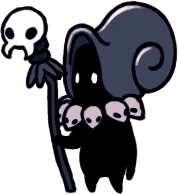
Bad news first; because of a whole bunch of complex events I have had to pause development on VotE ReDux till the first Snail Knight story is finished. I hope to be done with the basic text for SNAILS ALPHA by the end of September/middle of October so will go back to VotE then.
Queen Mabs' Palace
Its been just over a year since 'Queen Mab's Palace' was funded. In our latest update [CLICK HERE TO SEE IT] we have some images, thoughts by August on the arrangement of complex scenes and figures and confirmation that we expect to have the art complete mid-October.
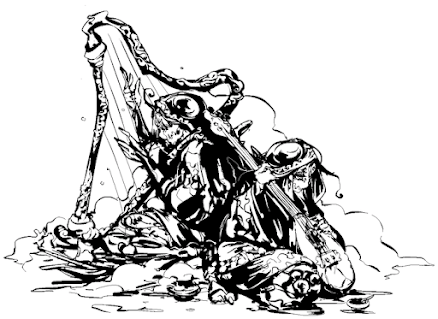
Once the art is done will will do another round of checks and layout and then hopefully move to printing, I hope maybe around Christmas? We will see.
It also depends if/when shipping to the U.S. resumes and how that happens. I have my fingers crossed.
Snail Knights
Some of you may know of my old Snail Knight stories. A long time ago I completed two stories, of a great plan I had for twenty interlaced tales.
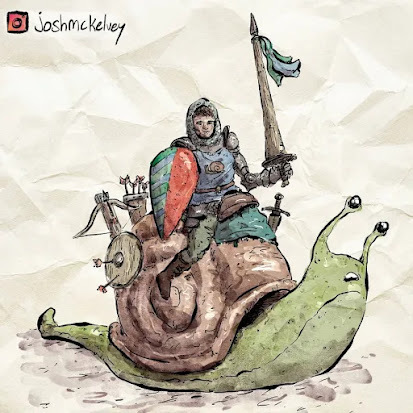 SUPERAKIDDO from Reddit
SUPERAKIDDO from RedditYou can read the first two stories for free by clicking here!
I have been persuaded to take up the stories again. So far I have completed four and am half way through the fifth. The stories have grown in depth and complexity as I have gone on, (and hopefully in skill). Each of them should be a self-contained chivalric tale, each of a different scheme, yet interlaced, so that it becomes a book of short stories that ultimately tells one great epic. (Jack Vances Lyonesse is maybe the closest equivalent).
Once the fifth story is complete, I will look into making these first five stories a physical book, a 'Part One' of a hopefully, eventually, Four-Book series telling all twenty interlaced tales as; ‘Knights of the Snail’
Like 'Queen Mabs' Palace' I intend for this to be fully illustrated, hopefully by Amanda Lee Franck. We will see!
That is what I am working on right this moment; the Tale of Sir Whirl. Once he is done I intend to move on to production for 'Queen Mabs' Palace' and development (unbroken this time), for VotE ReDux.
Current ScheduleComplete Snail Knights One base textStart production on Queen Mabs’ PalaceSomehow shipping to America Re-Opens!Re-Start development for VotE:ReDuxEdit Snail Knights OneRun a Kickstarter for Snail Knights One (February 2026?)
September 2, 2025
Un-American Activities
I am halfing prices for all False Machine books held outside the U.S.A.

This discount will last until sales the the U.S. are re-started, OR until the end of the year, whichever comes first.
(This is to keep my sales up so I can at least keep paying my storage costs.)
The new prices for everyone outside America will be;
Golden Duck - £5 to £2.50DCO - £35 to £17.50DBS - £25 to £12.50Gackling Moon - £25 to £12.50Gawain and the Green Knight - £15 to £7.50Speak, False Machine - £35 to £17.50
August 23, 2025
(most) False Machine sales to the U.S.A. are paused
Sales to the U.S.A. for the majority of FalseMachine Products are on pause.
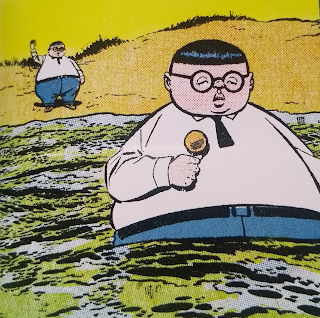
(Silent Titans is the one exception - it is stored in the U.S.A. and sales arestill active.)
This is not exactly my decision, my fulfilment company, Spiral Galaxy Games,won't currently ship to the U.S.
The main problem is the uncertainty of how the Tariffs will be actioned. To geta parcel to you my fulfilment company needs to interface with their deliverycompany, who go through customs and interface with USPD. Since its unclear if,where and how tariffs will be charged in this process, and if USPD even has thecapacity to deal with the charges, everything is up in the air till this isresolved.
There are a couple of possible solutions;
I will keep everyone informed as things develop!
August 11, 2025
MAC ATTACK - An Interview with Amanda Lee Franck
yes i am INNER CIRCLE
for a hot minute
sometimes and purely by chance
"Chris, this title is terrible" I said
and it is,
but I need not say it more than once surely (I probably will)
I have tried kitbashing a force for this and have played it once, (incorrectly), so this will be the first of a series of small posts about MAC ATTACK, probably far too late to do anything useful for its crowdfunding, which is happening HERE
This first post is an interview with the artist for MAC ATTACK - Amanda Lee Franck, (click for socials), who you may know from such works as ‘Vampire Cruise’, ‘Crush Depth Apparition’ and ‘You Got a Job on the Garbage Barge’.
The subject is of particular interest to me as it involves miniature wargaming, world creation, the involvement of art and design in differentiating and embodying factions and the interplay between painting, building, playing and pretending.
Here is the Interview!
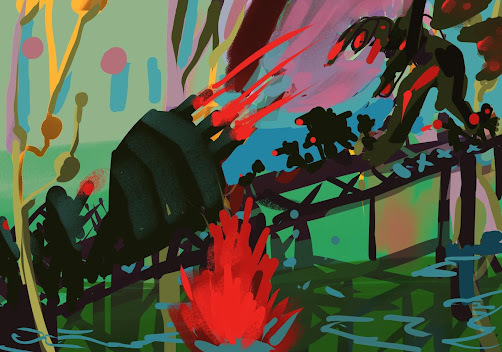 Cover Sketch - see below for final
Cover Sketch - see below for final
Patrick - How did you become involved with the project?
Amanda - Chris sent me a note cause he saw some spaceships I posted on I think instagram.
Patrick - How long has it taken from beginning to end?
Amanda - The art took from June of 2024 to late December (I did a little work on other projects at the same time but mostly it was Mac Attack). I am slow but also there were a lot of pieces! Also there are two entirely painted illustrations where I made a literal analog painting for them and that takes so long (paint has to dry). (all the others are analog ink drawings with digital color).
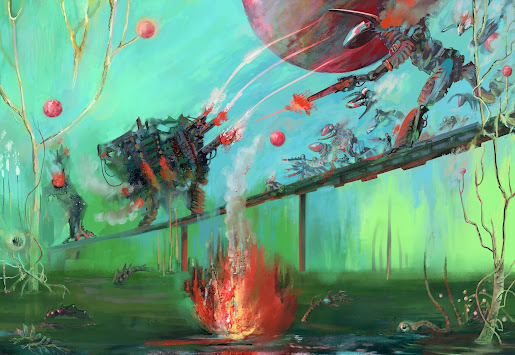 Cover Final
Cover FinalFACTION DESIGN
Patrick - We have ten factions;
Elder Circle
Grand Forge
First Regiment
Arksworn Order
Torchbearer Archive
Dynapolis Foresight
Vox Stellari
New Genesis
Monolith Conclave
Skyless Cartel
Patrick - Ten factions is a LOT for a starting Wargame. Three or four is more usual. In the book, factions are defined by a small clutch of rules and options, some example MAC stats, a single sentence modelling guide and your images. More; each is, or was, human, and each has some kind of shared history with the 'Humanity Fleet' they all descend from.
How did you start thinking about the factions - what was the exchange of ideas between you and Chris like?
Amanda - I have pages & pages of notes I took while I was trying to figure out the designs (Also Chris sent an art brief with notes about the factions). It is true that ten is a lot, and I figured my job in the pictures was to give each of the factions a visual shorthand: pick out whatever it is that makes each faction most distinguishable from the rest, and make a design that emphasizes that particular thing. So I took a bunch of notes & expanded on all the ideas and then went around & collected some visual references for each faction (mining equipment, home-made church banners, bug parts & so on) and then I tried to condense everything back down again and made each faction a sketch page with a drawing of a mech & a portrait of their leader & their capital, which I sent to Chris & then he gave me notes on the designs.

DIFFERENTIATING FACTIONS
Patrick - How did you differentiate the factions visually?
Visual Profile - Are the factions intended to have strong individual profiles? (In particular, some are 'nearly humanoid', while others are 'Crystally', 'Flowing' and Big Lump Things of various shapes.)
Substance - were you thinking about how people would build these, and of what? while you were drawing them?
PAINTING - were you thinking about people actually painting these things and did you consider colour schemes during the design process? To the individual factions have their own 'palettes'?
Amanda - I am answering these all at once:
When I started working on this I had not ever played a miniatures game or painted a miniature so I found a friend who had & asked him a bunch of questions about it & learned most importantly that picking out the colors of your guys was very important & that meant that I should not use color as key way of distinguishing the factions from each other.
Instead I tried to give each faction a super simple motif that was obviously different from the others (and not size or color based: something like: pyramids or drills or banners or the MACS have human faces attached. There are still color schemes that crept in as I was working, but they are vague: one faction being shiny and and brightly colored vs another faction being rusty & broken down vs another faction having painted on details as though the MACS have been decorated by their own pilots.
Patrick - Future Faction Definitions - Would you, either yourself or in combination with others, (Chris has an active Discord I think) be down for producing a 'Design, Colour and Heraldry' type book or file showing the world examples of how they could produce examples of the various factions?
Amanda - If I saw a model someone else made of one of the guys I drew I think I would feel the most famous a person has ever felt (I do not know very much about making models and could not be very helpful).
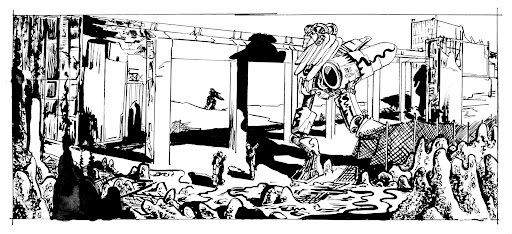
SMALL SCALE
Patrick - 6mm - this is an insanely small scale for a wargame. At this level the MACS (which are roughly the size of buildings) would be about the size on the table of a 40k Space Marine, or smaller.) Was this a deliberate choice to help/aid with Kitbashing and construction?
The scale influenced by other things (you can carry a small wargame around easily and its hopefully cheap to get into.)
6mm Vehicles and Infantry*. Did you put any thought into what the infantry and vehicles might look like?
Amanda - I don't know! I do not know the answers to these questions you will have to ask Chris!

KITBASHING
Patrick - Was thought given to Kitbashing, modelling and self-creation of MACs by the players?
Grand Forge and First Regiment both seem to have general humanoid forms, Grand Forge with spikes and First Regiment with those wild horns and crotch faces. Were these intentionally designed as factions it should be easy to Kitbash just by adding bits and pieces to humanoid mech models?
Amanda - Yeah, I was trying my best to do things that could be made with stuff you might have around (like if I was going to try making skyless cartel I would go get lots of screws or old drill bits & glue them together into a huge earth tunneling looking thing). I suppose Torchbearer Archive is for if you want a challenge cause I don't know how you would make them. You'd have to model the whole thing from scratch.
Patrick - You yourself have kitbashed some of the Arksworn Order. Can you tell us a little about how you did that and what your thought process was?
Amanda - As I have never done this before I would describe my thought process as trying things out, failing messily, trying a related thing out (this is also how I draw). Luckily I had help with glueing and attaching techniques and access to a marvelous parts horde. I managed to make ship's prow shapes out of some plastic card & a mysterious paste and I found a marble in a stream and used that to weigh down the back end so the whole fellow doesn't tip over on his face. (The marble collects and stores energy from lightning collected by the many spires up top). I tried to copy the colors I used in the 2d art (but I am not really satisfied, it turns out this is completely different from painting the way I am used to and I feel like I could spend weeks painting one of these little guys. and then smearing mud on them & then making them such as a light up diorama with explosions effects to live in oh no)
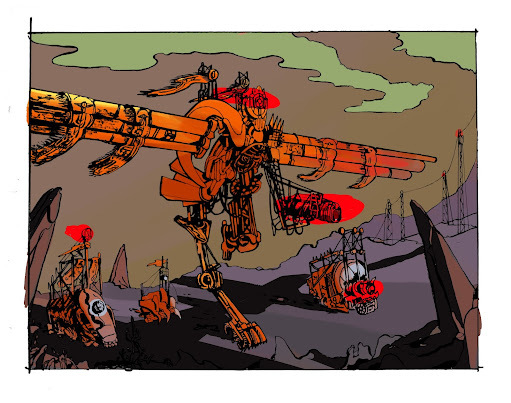
BOOK DESIGN
Patrick - What was the process of book design? Who did what when?
Amanda - Chris did all of it! He did the logos for the factions as well. He wanted a border to go around the edges of each page & I designed that to suggest a light-up instrument panel, with green-yellow-red going up to indicate your MAC is overheating.
Patrick - Spot Images - the book is full of pictures, small and large, from the world of MAC ATTACK. What where you thinking of when making these? Were you imagining particular moments between factions, images from real life? From your own imagination? Did you begin with the image and then place it in the world or something else.
Amanda - I actually made a complicated chart to make sure that I was drawing equal amounts of each faction and I used the inspiration tables in the book to help come up with ideas of dramatic things which might happen. The spot images are related specifically to the page they are on- the text was complete when I started working so I was able to do that which is always nice.

WORLD DESIGN
Patrick - The reality of MAC ATTACK is massively inferred from this element and that. How fully did you model this reality in your head? What kinds of things were you thinking of when representing it?
Amanda - I think I almost invent a new way of working for almost every project I do in the hope that doing so plus reading the text really closely produces a coherent place in my mind & then later in the art. The way the setting of this game is big: multiple planets: any kind you can think of! All kinds of guys! made me want to do things very splendid and colorful: big, weird, colors. And I wanted to use a bunch of the same oversaturated red (because of the overheating rule, which I suppose is an obvious choice but it ties all the images together)
When I was composing images I was thinking about trying to get at those moments when you are playing a game & you get a really good roll & your guy gets to do something so dramatic that it kinda hangs out in your head like a real memory of something you did afterwords.
Patrick - Future Works - will you ever be diving back into the world of MAC ATTACK in the future with any art, minis or anything else?
Amanda - I do not know but I have learned that I like making small things, which ought to have been obvious as I still think fondly of childhood school projects where I had to make a diorama in a shoebox of a book I read.

ANYTHING ELSE?
Patrick - Is there anything you really wanted to talk about or be asked about that I didn't bring up?
Amanda - I don't know if anyone cares about artist materials? But I could go into more process detail if thats at all of interest.
Patrick - So for those curious types; what tools, inks, papers, pens etc did you use? What was your method of working from first sketch to final copy?
How do you know when an image is 'finished'?
Amanda - I use sumi ink (cheap! comes in big bottle) and dip pen or tiny tiny brushes on some cheap printer cardstock (not as nice as bristol board, but close). Then I scan the drawings & clean them up digitally if I have made any huge mistakes and add color using Clip Studio Paint (a japanese digital drawing program which is better & cheaper than photoshop).
For the cover & the interior painted pieces I did actual paintings, photographed them, and then added some of the really really small details digitally. I have copied this process from someone I cannot remember who does magic card art, to be able to make an oil painting quickly enough: you can get in the big forms and color & texture pretty quickly in actual paint, and then work on top of the photograph of the painting for the little bits & highlights that would take forever if you had to wait for layers to dry.
I like to work with analog media because I think I make more interesting decisions when I know I can't delete anything. I started doing looser & looser sketches because it forced me to think harder & be more attentive- If you get something wrong you have to try to make it work anyway and I think that struggle is what makes the most interesting work (or you have to toss the whole thing).
I know when something is done cause it makes a kind of almost audible click in my brain.
*(Tanks, if they were actual size, would be about the size of peanuts I think while actual-size infantry would be like grains. Effectively this means Tanks and infantry on the table will effectively be represented by 'out of scale' models. Which isn't unusual for a small scale
August 7, 2025
'On Guard'
The PCs are hired as the Night Watch for the rear entrance of a Magical Academy. Their shift runs from sunset to sunrise and their only job is to guard a particular door, manage entry, and, if there are more than three PCs, patrol the perimeter.
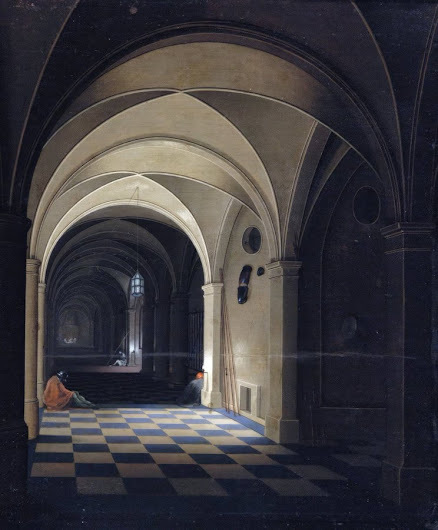 Pieter Neefs the Younger
Pieter Neefs the YoungerConceptsStay In Place
The PC’s cannot move. They do not go anywhere. They have to stay by the door, stay alert and stay On Guard. In case of a serious emergency, they could perhaps, walk down the alleyways behind the college, to investigate a fire, a dying man, a crashed cart or the like, but they better be back On Guard fast. But there won’t be a ‘Serious Emergency’.
No Drama
Almost nothing dramatic happens. There are dramas, conspiracies and crimes happening in the College, in the city, in the night, but the PCs are simply ‘extras’ in these plots and happenings. A man runs down the alleyway, veers into a side-street. Then a second man, perhaps a Hero or Detective, runs the same way; “Did you see where he went?” The PCs can answer however they like. This will be the limit of their interaction. They do make some decisions, which will have some effect, but they are not the main event
Long Term Awareness
A long time is meant to pass. Certainly months, perhaps a few years. The PCs have to save up money (and not get fired). One effect of this is the depth and detail revealed by the ever increasing familiarity the PC’s have with their small patch of space.
This area, around the rear wall and the rear door, its locality, everything near it and everything they can see, hear and smell, everything they experience in this place, they perceive with incredible depth. The details of the alley itself, its shifts and changes over seasons. Its stones and flags. Details of the view - like 'Rear Window' they see the same view every night and grow accustomed to its patterns, so much that when they change (the wrong light going on at the wrong time, a dog that doesn't bark in the night), they notice. Details of the soundscape - they hear the city round them, night after night, and know its rhythms and patterns, from market nights (lots of rats from the lost produce), post-festivals (vomit and people passed out), the regular closing times of pubs nearby, the brawls and drama they hear on Saturdays, religious holidays and the timing of bells and sacred services, through months and seasons, all of this becomes deeply familiar to them, so much that if the pattern changes, they notice. And minor things; the fortunes of a stray cat (regular visitor), corrosion of the brickwork, (“somebody needs to have a look at that”), a broken drain, a banging gate a mile away.
Minor Situations
The PCs have a list of people who are allowed to go in and out, and are definitely meant to keep a list of anyone who does.
What if someone 'very important seeming' turns up, but they aren't on the list, but they say its ok? If the PCs don’t let them in, they could get into trouble, but if they do let them in, they could get into trouble for that. What if this sets a pattern and someone starts taking advantage? What if they offer a distaff bribe? What about horny students climbing the walls? What about the woman you see in her window? The noises from the sewer? The sound of a thief fleeing in the darkness a street away?
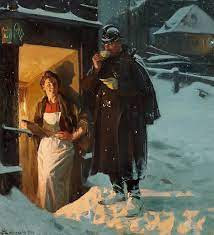 After the Night Watch by Erik Henningsen
After the Night Watch by Erik HenningsenWhat Kind of Characters?
The players could make PCs specifically for ‘On Guard’, but if incorporated into a wider campaign the ‘Player Characters’ of ‘On Guard’ could be;
· Old; PCs who have simply aged out of adventuring, but who are not so rich they can fully retire.
· Injured; PCs who received a substantial injury it will take time to heal. This could have permanently altered their employment prospects (‘Took an arrow to the Knee’) or they may simply need some time in a less-stressful position.
· Mentally Traumatised; or even cursed.
· Young; those who have not yet started their adventuring career, (and if they stay in this job, perhaps they never will).
· Under Cover/On The Lam; the Adventurers are hiding for some reason and have taken on false identities. Either as part of a larger scheme or simply to avoid the Law until the heat dies down.
If the PCs are still adventurers, they should have no particular scheme or idea in play regarding the College of Magic, or any nearby organisations. This would ruin the character of ‘On Guard’, which is meant, fundamentally, to be ‘about nothing’ or about what happens between and within people who are ‘doing nothing’.
 Antoine Auguste Ernest Hébert - On Guard
Antoine Auguste Ernest Hébert - On GuardThe Rules of the Job
You stay On Guard from Sunset to Sunrise. This means in Summer, hours are short, but the work is easy as its warm. While in Winter, hours are LONG, and the work is hard, (but at least you get paid more).
You take over from the Late Shift, who are supposed to maintain the gate, the record and the Watch House, (but often don’t), and you hand over to the Morning Shift (who are often late).
There is a Gate, a smaller man-sized Gate within that gate, a Watch House within the walls (one room), and a Rear Perimeter (you are not meant to patrol the front of the building – it has, or is meant to have, magical defences and a small guard staff who are much better paid and uniformed than you. You would make the College look bad to be seen ‘out front’.
Duties
You have three duties, depending on how many players there are.
· First and most important; two Guards (in Uniform, with halberds (this is non-negotiable)), must always be ‘On Guard’ before the Rear Gate.
· If there are two more, they should patrol the rear of the College, slowly, quietly, roughly once an hour.
· If there are two more, making six, then two can sit in the Guard House. Its one room with no fire, (but you are allowed a brazier outside in winter).
· There is a ‘behavioural code’ meaning no ‘slovenly or disruptive’ behaviour, including no ‘leaning’, no ‘leaning of Halberds’, no smoking, drinking, fraternising, game or chatter. No pets – has been recently added.
· There will be surprise inspections and regular checking of paperwork.
General Equipment
· Hourglass – this tells you which hour of the Watch you are in. (Though Church bells throughout the night will do this too.)
· Small Gate Keys - which you receive, (or are meant to receive) from the Late Watch, and which you in turn hand over to the Morn Watch. These open the small gate-within-the-gate, not the large one.
· Entry List - particular names who are allowed in or out of the Rear Gate. In some cases these names have descriptions, special seals they are meant to have, riddles or even stranger things. This also changes for mysterious reasons. You are pretty sure the Late Shift have added some things on there as a joke.
· Passage Log - the names of everyone who did come in or out. You are meant to record all of these, along with the time, any pertinent details etc.
· Watch Log - where you report.. well anything that happens.
· Equipage Log – where you sign in and out confirming that you have received all this stuff. (Oddly, the Equipage Log itself is not noted in the Equipage Log.
· Ink and Pen – this freezes in winter, dries in summer and the Late Watch always use it up and don’t replace it.
· Three Lanterns and enough oil for two Lanterns for Eight hours. (One is meant to be spare and they do not adjust for Winter or Summer hours.)
· Brass Whistle – this indicates the Watch Commander, (a near meaningless rank).
· Bell – to be rung only in event of attack on the school, but if an attack is underway, it must be rung.
· Lot Tin – for choosing who goes on Watch/Patrol/Reserve with who. The ‘Watch Commander’ can decide this, but the College recommends you take lots for it, to avoid cliques forming.
Personal Equipment
· Morion Helm – Non optional. shared with the other Watches. Most Guards wear a coif of some kind which they own themselves.
· Chainmail – shared, has to be adjusted for each guard. (You are allowed to bring your own armour).
· Halberd – shared and non-optional. A Guard ‘On Guard’ or ‘On Patrol’ must have their halberd with them and specifically in their hands at all times. (This is impossible while also writing down names). The Halberd does have a hook-thing on it you can hang a lantern from. The Halberds are very top-heavy and uncomfortable to carry.
· Tabard – with the Symbol of the College. Again, non-optional.
There is also a general dress-code indicating you should be reasonably turned out, facial hair trimmed, clean and ‘give a good account of yourself’. Added is ‘No slender knives, incendiary devices or knuckledusters’. You are not specifically banned from smoking, though without an ‘incendiary device’, how can you light anything?
 The Night Watchman by Karl Martin August Splitberger
The Night Watchman by Karl Martin August SplitbergerKinds Of Schedule
The substance of the game is made up of layered patterns of time. Rhythms of events sensed by the PCs, layered over and upon each other, each subtle changing according to circumstance of the time of the year.
Remember the deeper one gets into night, and the quieter everything becomes, the more sounds seem to carry. Sounds usually inaudible become more tangible. A single iron-wheeled cart several streets away is virtually inaudible in day, very striking after midnight.
The life of the City
· Last bars putting out, (these may have different characters).
· The last carriages leaving, wheels striking the cobblestones.
· Bells ringing.
· A dog that always barks when its master comes home.
· Garbage men making their rounds,
· Sewermen and Gongfarmers.
· Bakers arriving for work and their bakeries lighting up.
· The sound of single horses hooves moving at midnight.
· Traffic, the tramping of feet, of horses and cattle, dying away around sunset and building again before dawn.
· A dawn chorus when the sun rises.
Animal Life
· Stray cats.
· Stray dogs (rare).
· Rats in the street (where are they going to or from?).
· The occasional owl at night .
· Urban foxes.
· Lost stray or rare domestic animals, a lost pet from somewhere (maybe in the college, an escaped test subject)
· A run-away horse or donkey several streets away.
Plant Life
This changes more than anything season to season. Everything tangible to the PCs is very small, stuff people passing by likely wouldn't notice.
· Flowers growing in the wall.
· Weeds in the gaps in the paving stones out back.
· A small tree starts sprouting - pull it out?
· Things growing in the gutters of the buildings up above.
Slow-time senses
The things you would only notice if you were in a single place, listening and watching, for a long time, time after time.
The wind turning the weathervanes. Shifts in the winds sound as it moves its direction; from some angles it is displaced over the roofs, from others, funnelled by the streets and whooshes down your alleyway
The pulse of water running through drains in the minutes after a sudden shower. Anywhere dripping water lands just-so on a resonant surface, making a lout repetitive sound.
Any door or gate, within half a mile that swings regularly in wind. Even if the noise is slight, its rhythmic irregularity makes it highly noticeable in the middle of the night.
In the darkness, the ground only visible from the sheen of lamplight on wet cobbles, or the little pools between them, making a gridwork of light, the trail of particular snails across cobbles or bricks. the general prevalence of snails and slugs at certain times. A hedgehog!
Sounds of the Academy
What is even going on in there? It’s a magical Academy right? - and a Hogwarts style thing, so there are going to be students sleeping overnight, presumably broken up by house and gender, so you may have some Harry Potter little shit, or groups of little shits, running around in the night on some 'adventure'.
Overnight Experiments – it’s a research school as well, magical research I would think, so with some alchemical or ritual magics, you are going to need to be going all night, possibly over several days, and so have people attending to the 'reaction' or the 'summoning' all night.
Plus MIDNIGHT is always a magical time, so every night at midnight there is maybe going to be some chanting and/or some lighting or electricity going on.
Most astronomers would likely have to leave the city to observe, but you would see them leaving and coming back in the dawn.
Wizards making magical doors in the wall.
A well-known 'climbing spot' where students can get over the wall and go about in the city acting tough, thinking they are cool, and you can possibly get bribed by them
I probably need to do a whole section on bribery.
Possible monsters/vampires/doppelgangers trying to get in/out, like a guy who is clearly a pale jelly-like simulation of someone else, so you just don't let him in. (This would conflict with the ‘no drama’ rule.
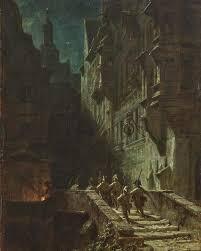 Scharwache by Carl Spitzweg
Scharwache by Carl SpitzwegHow do you actually 'play' this game?
The actually-difficult part. There is a reason, after all, that no-one designs games like this. Ultimately this is not a thing where challenge is going to be a huge part of the game, people are largely going to be there because they want to be, but it still needs to be some part of the game. So far I have no actual plan, but only concepts….
Time is the Enemy
If Time really is the enemy, then any challenge of this adventure lies not necessarily in facing any particular event but in simply getting through the night. A failure state means what exactly? You get bored, fuck up, get your pay docked, get fired?
Don’t Be Noticed
A useful concept might be that at least one member of the crew is genuinely ‘hidden’, maybe an ex-criminal or in hiding from some other organisation, and they really don’t want anything to happen. In that sense, ‘getting through the night’, like getting through a bunch of nights, without being fired or reprimanded, but also without being noticed or remarked on, adds more of a gamic element.
Its tempting to make it so that every member of the crew has some particular reason for not being noticed, or a particular desire specifically for nothing exciting to happen. Making them all explicitly, or secretly anti-adventurers. But that alone makes this perhaps more of ‘game’ than I originally conceived it as being. (Though much more tangible to a wider audience.)
Near Real-Time
Concept – the game at its basic level is lived almost in ‘real time’. You simply live through the 'hours'. Most of the ‘action’ of the game is trying to find things to do that will ‘speed up’ time, while also not actually making you bad at your job or getting you into shit.
Betting Time
One concept is some kind of 'betting system' where the PCs can 'bet' time, but the more time they 'bet' the more likely they are to be inspected or to get something wrong somehow, thus throwing them back into ‘real time’, and/or giving them some kind of negative event.
Ways to ‘Accelerate’ Time
Perhaps you can accelerate time by telling each other stories, playing games of chess, (presumably inside the guard room), having random conversations etc. Maybe this could take advantage of the slightly sopophoric sleepy regular intonation of events – if PCs can have random conversations about the sound of a bell, or a dog barking, that’s fifteen minutes or half an hour taken off. This would be defeating time through role play.
A Boredom Score
Maybe the pcs have to roll (collectively) against boredom? Or to roll awareness, and if they succeed, they get a richer, more detailed story of the events of the watch, while if they fail, they get the bare information.
We can do this hour-by-hour with each hour being a separate roll, and with environmental effects and the various preparations for them also affecting this. Like - you are not meant to have a chair out here, or to lean against the wall, (a brazier is allowed in winter), but you can kind of fudge this by keeping a secret chair, or by covertly leaning against the wall, or leaning your Halberd against it, maybe this brings down your Boredom Score, or makes time faster, but with some secondary negative effect, getting caught or being punished some other way.
‘Islands’ of Events
The big problem with this information is that its NON INTERACTIVE (or much of it is). Maybe I could break the 'watch' up into 'islands' of minor interactable events, like a cat visits, someone throws up on the street, a visitor comes to the rear door, and simply have long chants of information between each 'event'.
……………………………………………….
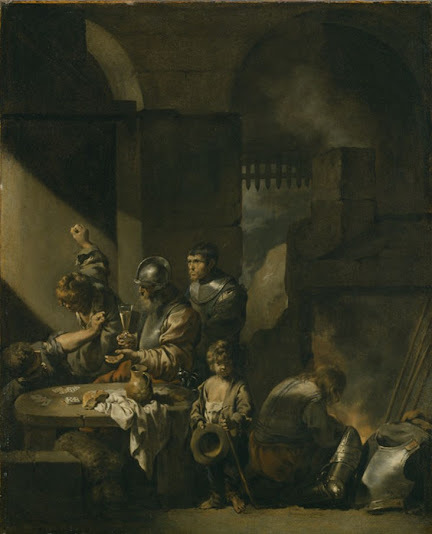 Sébastien Bourdon, A Brawl in a Guard-room
Sébastien Bourdon, A Brawl in a Guard-roomWell, ‘design’ questions like this are part of the reason comment threads exist.
News!
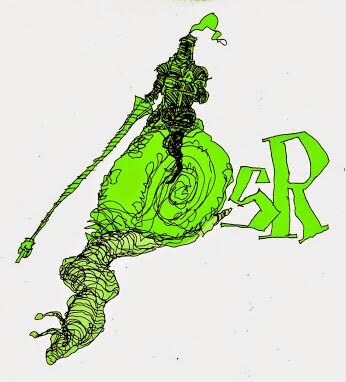 Matthew AddamsThere will be, hopefully, a Snail Knights book.
Matthew AddamsThere will be, hopefully, a Snail Knights book.These are a series of stories which I began back in 2015, then stalled on ten years ago. I completed two of them, which have appeared in various formats, and which you can read for free here.
Encouraged by a friend I have been working on more and have completed Story Thee - The Tale of Sir Babbling, and Story Four - The Tale of Sir Lucent Void. I am currently working on Story Five - The Tale of Sir Whirl.
If I can complete five stories the result will be a novel-length fully illustrated book, hopefully the first book of Four, ultimately containing twenty interconnected Snail Knight stories which tell the Whole Saga.
June 30, 2025
Loopy Tombs
This poast was inspired partly by reading James Holloways 'Tome of Tombs' - a zine of Tomb creation which you can find here; https://james-holloway.itch.io/

A aid to generating tombs based partially on the creators IRL historical knowledge.
Reading this I realised that the most interesting thing about most pseudo-real tombs, in terms of exploration and dungeoneering, is the context.
In real-life tombs, at least anything under a pyramid in size, you go in and come out. the 'flow cart of possible exploration is very linear, though the paths within the tomb might seem winding.
Holloways Zine deals well with the creation of this context, but I was interested in crossing the streams somewhat, and thinking about reasons a pseudo-real Tomb might have the loops and choices we often desire in dungeon design.
What follows starts with pseudo-real reasons a Tomb might 'loop'; 'Living Beings', 'The Touch of Time' and 'Architectural Reasons', but rapidly spirals out of control into the whackiest possible sources for complex tomb layouts.
Giant Sloth - In an adventure beloved by few, I used the giant south American ground sloth burrowing in and about the tomb, creating a series of alternate passages which wove in and around the 'natural' pathways of the tomb. Many creatures burrow but few IRL creatures make man-sized burrows. If you wish to confine yourself to creatures that have lived, or that do live, I think its either the sloths or the Honey Badgers. (Place your answers in the comments). (Of course one living creature that does produce man-sized burrows, is man, which leads to the next entry.)
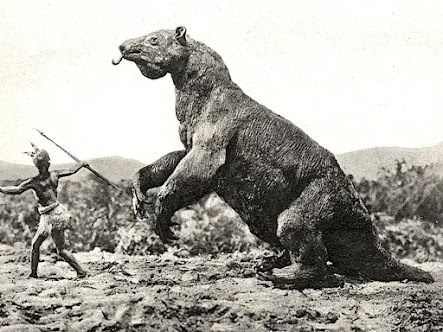
Lair of intelligent creatures - Its a classic for a reason. Clever beings lair, or have done, in the tomb, they have expanded the place, putting in their own obvious and hidden routes.
Massively overbuilt - Multiple religions or cultures have occupied this site and all built on it, or the same religion over a thousand years, (St Peters in Rome has an insane number of underground levels, each of which used to be the main level). This can also expand the 'tomb' laterally as the buildings placed over it expand.
Built onto, and partially collapsed into, deeper tomb or necropolis - They either didn't know it was there or simply forgot. Now the floors and stuff have fallen through into the deeper levels.
A river ran through it - or a stream really is all that’s necessary, and it may well have dried up since, but at some point during the life of the tomb, a water-course has shifted and run into it, drowning some areas, breaking through some walls, finding its way between places, and leaving unexpected routes.
Banyan forest - tomb is in a tropical environment, huge marvellous trees have infested the place, layering over and around, teasing aside the great stone blocks and opening strange ways between their complex root systems.

ARCHITECTURAL CHOICES
Maintenance Spaces - another thing I tried using in DBS; designer/creator access/trap reset tunnels for the architect themselves. If you want traps or any kind of complex 'effect' you may need complex mechanisms, or at least weights. To organise and set those up, you might need crawlspaces or other access spaces, that let you into the rear or back of rooms or setups.
Escape Route - the classic fear of being buried alive. Leaving an actual potential escape route for the 'corpse' should they be buried alive would effectively make a secondary network of tunnels or paths in the structure, leading directly from the body to the outside, but presumably very well camouflaged and perhaps only openable from within.
Spiritual Labyrinth - either to make sure the dead do not find their way out again or to baffle and disturb any negative spirits who might try to reach them, you build a complex labyrinth between the body and any possible exit. Spiritual - and therefore a bit different from a 'tomb robbers' labyrinth in that there may be no actual lethal traps or mortal deceptions, but may be a lot of complex religious trickery.
Double or triple fakes - I have used this myself previously. Just build a fake tomb, with fake treasures, then for people smart enough to see through that, build ANOTHER tomb, also fake, then an even-more-hidden third tomb, the real one, (this does not guarantee LOOPS though).
Palace for the Dead. It’s not enough to just have, for instance, a room or something, whoever is buried here will need an entire dead palace full of dead luxuries, all mirrored and replicated from the living world, which means their tomb will be a buried palace, with all the corridors and extra ways implied by that.
Mandala Map - the tomb has to be a physical map of the spiritual world as imagined by the deceased, so it’s like a giant mandala, embossed into physical reality. (Having some knowledge of this belief system would really help).
I should be able to think of something better than this, what are the...
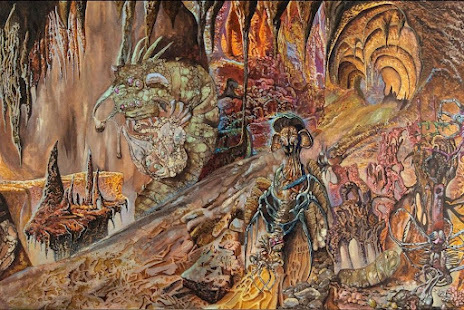 Cover to Manor of Infinite Forms by Tomb Mold
Cover to Manor of Infinite Forms by Tomb MoldTime Loops – it’s a classic. If you die in the tomb you *don't* die in real life you just time loop back to certain 'save points', but some of these are so horrible - bounded on every side with impassable traps and dangers, that being trapped in them is a form of eternal undying madness.
Doors into Dream - certain symbols send you to sleep where you must navigate the tomb in dreams (the dream structure is significantly bigger).
Size Alteration and Rat Tunnels - rats have made their own paths, at the same time, eating the strange flesh of the tomb will shrink you down to their size, for a while.
The Statues Came Alive - and, unable to find their own way out, carved their own tunnels in the earth for their own reasons (seeking perhaps to get away from each other). It seems reasonable that the spirit of a god, or part of it, might come to inhabit, for a while, an image made for it, and perhaps it would be really annoyed at being stuck.
Reality-Distorting Artefact - Sword of Leaves, or similar, is buried with the corpse. In combat and legend it simply cut through the space around it, granting semi-anime powers to its holder. After being stored for a few centuries doing nothing, its nature to warp space around it is creating labyrinthine structures from simple ones, nesting excess space in unobserved corners. Now residents are appealing for someone to actually go and rob the tomb; the extra space is leaking out into the surrounding community and breeding labyrinths and impossible spaces in corners. The sword should be fine so long as someone keeps it on the move, only starts leaking if you leave it in place for a century or more.
Builders Buried Alive - perhaps to keep the tombs location secret, its builders were buried alive within, but they reanimated and, consumed with their last memory, have kept digging and building in ghost and skeleton form, weaving the tomb ever deeper into earth and stone over the centuries.
Hell Itself - the resident was so exceptionally evil that the forces of hell tunnelled directly up from hell to grab their physical remains to which their soul was attached, the tomb is now fully interwoven with the distant outskirts of hell.
Religious Teleport – it’s a linear, maybe EXTREMELY linear, single long straight path with various doors, alcoves and statues along the way. The doors and other stuff can teleport you forward and back along the main route, meaning that 'in effect' the path is looped. We could call it 'The Long, Straight Dungeon', or the 'Five Mile Dungeon'.
Dickhead Teleport - tomb is physically linear though not to such an extreme sense as the five mile dungeon, but various items and interactions teleport you back to the 'starting area', meaning you have to keep transiting the same space trying to work out how to avoid or subvert the teleport effect.
Mirror World - various bronze mirrors in the tomb give access to the 'mirror tomb' which is basically a different (now spooky) version of the same thing, there are always two or more ways of encountering or dealing with everything now. When you leave, try to make sure you are in the actually-real-for-you version of reality.
Cancerous Brick - through curse, fluke or magical overflow, one particular brick or tile used in the construction of the tomb, has meta-cancer, meaning it will just keep replicating itself and the context of its placement over time, this means at a certain point the tomb now just dissolves into an insane mycelium web of brick or tile tunnels. The purpose of these tunnels is to *be tunnels*, simply to hold replications of the brick or tile. Dungeon chemotherapy might involve finding that one cancerous brick and smashing it, or smashing ALL the bricks or tiles - locals may have started invading the tomb to harvest the superfluity of bricks/tiles which now makes up their main local building material. Nothing can or will go wrong with this idea.
Djinn Dumping Ground - for whatever reason, whenever a certain Djinn or family of them are ordered to build or disassemble a castle or something, they need somewhere to store the stone, and have chosen here - they have built huge warrens and caverns of utterly random shit based on building materials from over many millennia covering the whole world, if they are uncorked somewhere and ordered to make something, they may turn up and start disassembling this stuff.
Gravity Shift - the long, spiralling yet linear way has a super-high ceiling and there are certain gravity shifting things in the tomb, or just ladders between the up and down, so that there are in essence two corridors or paths through, with one set of things and challenges on the 'bottom' and one on the 'top', meaning everything is technically looped.
Paths of Memory - various mosaics etc in the tomb represent the memories of the inhabitant and staring at them for a while can drag you into those memories AND - they are made too well so, like real memories, they interact and meet up at points, based on theme, mood, strong emotion or sensory factors (smell especially, which often unites memories), so that you can, deliberately or accidentally, move from one memory to another and emerge somewhere else in the tomb.
June 19, 2025
Dead-Eyed Dwarves - development for VotE; ReDux
The Dead-EyedDwarves are bald and bearded, shorter and stronger than men. They value onlywork and blood.
Appearance
STOMP STOMPSTOMP – the heavy iron-shod boots of Dwarves passing invisibly but for glaringlamps and lances of light.
For theDead-Eyed Dwarves have many magics; cloaks which make the wearer invisible,clicking rings which make their owner large or small, strange insect-lenseswhich pick up every drop of light and ever stranger eye-wear; pearl-palecyclopean masks which perceive the flow of ‘dark’ itself and twin-cone faceswhich turn rebounding clicks and whines into images in the air. Beneath these,often, grills or tubes, breathing apparatus or voice amplifiers, who knows.Beneath those; beards.
Their lamp areharsh, actinic and directional; itself a near-aggressive act within the Veins.The blinding sharp-edged light turns the Dwarves behind them into silhouettes. Thetramping, trudging, armoured and indifferent Dwarves. Few cultures of the Veinsdare to wear full-armour underground; none but the Dead-Eyes possess the craftto endlessly clean, amend and fix their metal shell, the brutal endurance tocarry metal weight, nor the size-shifting techno-magic which lets them shrinkand grow, giving them access to shafts and warrens which others attempt only inextremity.
They can passinvisibly, but they are loud. Stomp, stomp, stomp. Too big, too small. Disappearingin the blink of an eye. Hooded, armoured, masked, with wild prickling beards.Lights powered by crackling batteries which drip toxic alkali slime. Loadedwith crossbow, axe and pick, careful maps and guidance dials, grappling hooksand superlight chains. Walking and moving in unison, grunting to each other in mutteredsubsonic; a guttural under-speech, as if they resented even, the need to speak,even to each other.
The most likelyencounter is that you are simply ignored. The cost/benefit assessment ofenslaving you simply doesn't move the dial.
The Dead Eyes

Things don’t getbetter when the masks come off. There is just something missing in there; thestrange, deep-time, assessing gaze of a Dwarf, but with the humour, honour,boldness; gone, washed away, leaving what? Eyes pale as slate, empty as theletter O.
They eat,breathe, smell, move like living things, more than many in the Veins, yet avampire, or a crazed patchwork Gilgamash, can have more 'anima', moreindividuality, vitality and humour than a Dead-Eye Dwarf.
They are notpleasant to deal with, but they are reliable, practical and rational, andthey think long-term, which makes them an incredible stabilising force. Yetno-one, and nothing 'likes' the Dead-Eyed Dwarves.
AbilitiesPowerful Lights
Bright whitespheres, hanging lanterns and lances of burning white light. Used to blind ordisorder seeing foes, or simply to pick out blind enemies.
Invisibility Cloaks
Heavy toxic thingswith pointed hoods, less useful in the Veins than you might think, these areused mainly in raiding other lands. When wrapped around and buttoned up,everything they cover turns translucent. Complex physical movements, like mostforms of attack, will make the wearer visible, at least for a moment.
Size-Control Rings
Heavyclick-clacking bracelets which turn like locks or rings of code. Rapid tactilecodes are needed to make use of one, and once that code is known, each ring isstill is different, tuned for a particular Dwarf. Worn, usually on the left arm.Move the right hand over and quickly, and loudly, click through the code beforecarefully carefully carefully clicking through the size-set sequence.
When a Dead-EyedDwarf shrinks or grows, its not a smooth transition. Its as if they were animage and each heavy CLACK spun some fresh lens in front of them so that theyseemed smaller or larger by leaps. CLACK CLACK CLACK and big, big BIG, as ifthey were projections, with the ‘real’ dwarf somewhere else.
It takes time andtraining to accustom oneself to getting bigger and smaller on the regular.
Seeing Lenses
They like these,though its questionable how useful they are. Varied masks and lenses, the mostcommon are Light-enhancing eyes, heat-trace Snake-Pit lenses and Sonic Lenses.More rare are the special ‘Dark Vision Lenses’ which literally treat darknessas a substance.
Each Dwarf willonly have one set of Lenses, if they have any, and few groups will have morethan one set of each kind. They are hard to make, maintain and repair and eachDwarf makes their own.
Mouth Masks
The Dead-EyedDwarves don’t even use gas that much, purchasing it from the RayMen occasionally,but they like to wear the masks. Some protect from gas, some change the voiceto a harsh bark, others alter voices to simulate those heard, still othersprovide air should the Dwarf go underwater, or into airless spaces.
Again, each Dwarfonly has one set and the whole group rarely has more than one of each. Its nota systematised technology.

Morale plays nopart in the decisions of the Dead-Eyed Dwarves
Everything is basedon their immediate objectives. If violence is required, and they think theywill win, it starts at once, without warning.
If victory becomesimpossible, or if the situation changes, so that violence no longer serves,they simply stop, again, without warning, usually turning invisible and simplywalking away.
If there is no wayout, they fight, bitterly, to the emotionless end
Combat Tactics
Armoured;the Dwarves can weather most projectiles, and most blows.
BrightDirectional Lights; these can be used to blind many Veins inhabitants.Activating then turning off the lights can be more effective than actualinvisibility.
InvisibilityCloaks; if out-ranged, bottled up or boxed in, a combat team can use theirinvisibility to close with the enemy, or to escape if needed.
Size-Change =BIG; The Dwarves can ‘click-click-click’ up to Ogre size. This always takesan action and is loud. All of their equipment changes with them, as if it, toowas being projected from somewhere else. A Dwarf might turn huge and fireballista-sized crossbow bolts, or get close before turning massive and layinginto a party from behind its lines.
Size-Change =small; mainly used for escaping should a situation turn bad, especially byaccessing crawl-spaces or similar. Combining this with Invisibility makes themnear-impossible to catch.
The enormouspower of their techno-magical abilities, combined with their utter ruthlessnessand invincible will, means the Dead-Eyed Dwarves don't need fancy 'tricks',though like many Veins cultures, though they have an expertise in Poison (towhich they have a meaningful resistance), and sometimes use various forms ofGas.
Chameleon/Tarantula Cavalry
Mainly used inand around their settlements, due to the enormous costs of keeping them fed,but the Dead-Eyed Dwarves do often use ‘Cavalry’ formations; their favouritesare a very chunky form of huge Tarantula, and kind of sticky lizard with someChameleonic abilities.
They willusually change size to something smaller in order to comfortably ride thesethings. The combination of activating their toxic invisibility cloaks, thegiant animals, and the glaring lights they carry, creates a truly bizarreappearance.
The Dead-EyedDwarves don’t carry resentments around, if they beat you before, or were beatenby you, their attitude will be what it always is - relentlessly practical.
This makesconflict with them a troubling experience; they will not try violence unlessthey believe they will win, and they are rarely wrong.
Non-Combat Encountersthe Dead-EyedDwarves will pass invisibly, except for their lanterns. They seem like trudgingshadows passing underneath an actinic light which glows like a willow the whisp.
Did they justwalk right past?
Whatever theyare doing, they are doing it. They have a purpose and if the PCs cannot help
or impede them,what do they care?
Goals of the Dead-Eyed Dwarves
[THIS NEEDS WORKBUT HERE IS THE BASIC IDEA
A simple way todo this might be for there to be three goals;
One BIG THINGthat the whole of local Dead-Eye Dwarf culture is currently aiming towards. Youroll for this when you are generating the Veins and it remains the samethroughout the Campaign.
Two –a mediumscale political or large structural goal that will help them towards the MAINTHING. This can change from session to session and can differ from settlementto settlement. (But it doesn’t have to change). You can roll for thison-encounter, or during the session or just keep it from previous sessions ifthat make sense.
Three - acurrent goal for *this particular group*, the mission or thing they arecurrently trying to fulfil, which will lead towards the second, which will leadtowards the third. You roll for this when you encounter these guys.
Do, whenever youare dealing with Dead-Eyes, just look at this list; they are doing A, toachieve B, to finally achieve C. And all you need to think about, as it is allthe Dead-Eyes are thinking about, is ‘how do I achieve the next goal and makesure it connects to the main goal’. ]
They must alwaysbe working

Simple Behaviours For Encounters Literal
They do not likemetaphor. Things mean one thing. If a thing tries to mean two things then itbecomes nothing.
LITERAL DOESN'TMEAN STUPID - they do not like metaphors,but they understand them. They know that you or other characters, arenot being literal, and they can understand that, but they themselves will doeverything they can to avoid it.
Taciturn, Concrete, Direct
Get to thepoint, get there now and be explicit about what it is.
Use the minimalnumber of words to make things clear.
Do not 'chat'. Everyconversation has a clear and concise point towards which they are going.
Dead-Eye Culture
Long ago thefirst of them emerged from a distant primal core. He made himself. That workgoes on. They believe they are improving. It is their mission to do so.
Their familytrees spring up, not down. Each generation more focused and efficient than thelast. This is the Ascent. Dead-Eye heredity. A machine of blood and bone,carrying them into the pre-remembered future. One of only two things in whichthey truly believe.
They havestatistics, and the graphs all show a clear upward trend. Production,efficiency and development, all increase.
They imagine thefuture and the things they will build there. It belongs to them. They want itmore. They understand it more. They will become what the future needs them tobe. The future is a god to them. A god-above-gods. They know it to be true.
Even as the raceslowly winds itself deeper and deeper into the earth, passing through frettedvalves and carved abandoned chambers they have made, falling in its orbit ofstone, they map their continual advance.
Each thing mustbe built upon another thing. A word, a deed, a thought, each must have itsfoundation. Arguments over the Ascent are arguments over reality itself.Without its sustaining foundation, the word becomes a gabble of sound, the deedan accident, the thought a dream, the existence a lie.
Dull
One of the mostpowerful, wide-ranging and transformative of all the cultures of the Veins, theDead-Eyed Dwarves are dishwater-dull, to deal with. Utterly reliable and quiteinsane, they are a power second only to the Aelf-Adal, to whom they are almost immune,and with whom they enter irregular war.
Makers Of Ruin
The totality oftheir physical effect on the Veins of the Earth is enormous. Dead-Eyesnever stop working, mining, carving, delving. They are always building,cutting, shaping, and thence always moving.
They cannot stopworking, ever.
This makes a Dead-Eyecity or settlement, more like the cast of a worm than a singular place. Theymine and carve EVERYWHERE, continually, they do not stop to inhabit very long. ADead-Eye settlement is like a time-worm; it’s not located in any particularplace but is continually being delved, leaving the carved and developed volumesbehind it, like the cast of a worm.
The Dead-Eyestherefore make the Veins more ‘ruined’ and more ‘empty’ than they wouldotherwise be, for an empty building can be empty in ways a cave cannot.
Dead-Eyes dostill consider that they 'own' anything that they have worked on, (that theyhaven't formally agreed to sell or exchange), which means these vastPiranesi-ruins that plunge through the Veins are technically 'theirs'.
Neutral, Practical Evil
Dead-Eyes do nottorture or psychologically destroy their slaves. Not deliberately at least.They simply kill them when they fail.
Skilled slavescan appear to rise far in Dead-Eye ownership, and will (any skill at work mustbe nurtured and sustained so that better work may be done). But it is not theindividual that is respected. It is the work. The work passing through thealien flesh.
They do notreally hate their slaves. They do not realise that they are beings at all. Onlyvectors for work.
They do notreally hate anyone. Because they really don’t know there is anyone there tohate.
Neutral, ultra-reliable,non-bigoted, they may be the sanest (?) culture in the Veins.
They arehonestly quite boring to encounter and maybe that's ok. Remember it’s not aboutoffending them, it’s unlikely you even could offend them, it’s aboutgetting in their way, and if you do get in their way, they will grind throughyou and over you with utter ruthless indifference. It’s almost like fightinggolem.
Skill Is Meaning
They respectskill. But it is the skill itself they respect, which is work movingthrough the body, not the body or the person itself, which are just bearers ofthe skill.
Work Is Meaning
The only otherthing they understand is work.
A body and amind are only useful because of the work they can together do. The soul is thework passing through the flesh.
No other racegrasps this. They might ask “What are the Dead-Eyes working towards? What istheir plan?”
They are workingto be working. Work is the plan. Work is the point.
They will neverstop. They can never stop.
They will cutcities from bare stone, tear up every vein, embellish every surface, then, whenthere is no unworked spot or unplanned gap, when every single piece and thinghas become a channel for planned creation, when even the pebbles stare up fromthe floor with idly-carved eyes, then they move on.
Gems meannothing to them except that they can be cut, or have been cut.
If one loses theability to work and if they cannot further the ascent, they simply walk intothe dark. Or sit where they are, staring at nothing, waiting to starve.
if a Dead-Eye iscrippled or otherwise prevented from working, they lose any will to live. They mustwork, they must proceed towards the goal. It is all they are. It iseverything they are.
Jealous
Yes, ok, perhapsthey can be a little irrational. They are still Dwarves after all. Theycan be jealous of craft and ownership, especially of unique objects andmaterials. The RayMen and their wonderous tech inspire some of this, but manyethnogroups have a little this or that which really, really, should thatnot truly belong to the Dwarves?
No Dreams
They do notdream, rather they experience a lucid ebony. Its possible they are not even reallyunconscious, just ‘shut down’. What are the Nightmare-Men going to do? Givethem a spook?
Fidget Spinners
Since theyliterally can't stop working, they tend to have a lot of ... odd things they dowhen they can't physically work, like knitting. If they are waiting, they carvestones or rock where-ever they sit down, leaving tiny faces in pebbles or mapson flat slate. (Although you never actually see them 'waiting’.)
DON'T FORGET;
The False Machine sale is STILL ON (I may or may not change it at the end of this Quarter, still thinking about that).https://falseparcels.bigcartel.com/
A Night at the Golden Duck = £5Deep-Carbon Observatory = £30 (-£10)Demon-Bone Sarcophagus = £20 (-£20)Gackling Moon = £25 (-£5)Gawain and the Green Knight = £15 (-£20)Silent Titans = £40Speak, False Machine = £30 (-£20)
AND! - A FREE HEIST PLAN FOR EVERY (UK-BASED) ORDER - WHETHER YOU WANT IT OR NOT!!!!
ALSO;FALSE MACHINE WHOLESALING!
False Machine is now available for wholesale!
If you are interested contact me anywhere to find out more!
June 13, 2025
“The Map of Five-Times-Five
The paper was flayed skin. Around its borders were these words; “A map of Signs, like those which show the way to Grace or Down to Damnation, through good deeds or bad.” I studied thus and decided that the Great Signs must be the Saints, but of the lesser Signs and lines I knew not, but went in search of one who would speak to me of such, for ‘Five-Times-Five’ had gone.”
I mean how good a map do you expect to get for one tooth?
.....
In this opening part of 'Queen Mab's Palace', our Narrator, the Scribe, has arrived in the Crypt of her Palace, in the shadow of Saint Seven, the Time Saint, and fortunately, on that Saints Holy Day, meaning they arrive in the middle of a Market, and that it would be illegal to hunt and eat them, (at least within the bounds of the Market itself, and at least till the end of this Saints Day).
In attempting to learn more about the strange, dank Fairyland in which they find themselves, they (somehow) end up in position of (someone's) teeth, one of which they trade to 'Five-Times-Five' for a map of the crypt in which they now are set.
This is that map;

What we know but they do not, is that the 'Crypt' is the broken, de-powered and/or industrial sections of a gigantic space ship. If you could see ‘the crypt’ in a 3D image of the real-life ‘Queen Mab’, it would be like dark sections, occupying most of the shitty parts of the ship, the stuff around recycling, the ‘lower decks’ main cargo bay etc.
Seen like this, the ‘Crypt’ isn’t just a single blob of contiguous space, it would weave its way through and into the ‘Courts’, like a black dirty Octopus spreading tendrils everywhere.
The division between the ‘Crypt’ and the ‘Courts’ is as much social, political and religious, as it is material and practical. The ‘Crypt’ is dark, often wet, full of naked industrial machinery, often hot, or maybe far too cold. Its population are the ‘Dwellers’ a peasant/untouchable class.
To make some sense of this, consider a Medieval Map like the Hereford ‘Mappa Mundi’, the religious centrality of things is important. Here is a medieval map of the whole world;
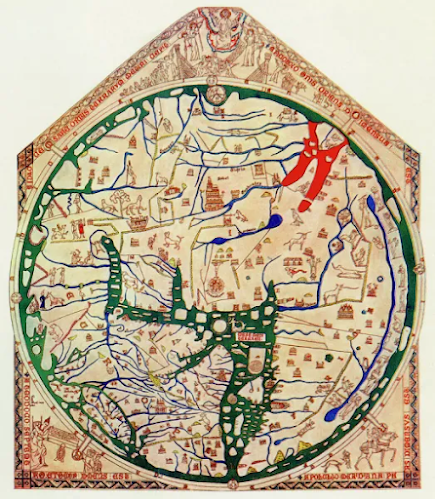
As you can see, the whole world is represented. In the middle is Jerusalem, the holy city, and below it is the Mediterranean. I think the UK is bottom left.
The thing in the middle of the Crypt Map is the Court of Melinoe, Queen of the Underworld and beloved by all who Dwell Below.
The FlowThe ‘Flow’ is anything the Courts (above) flush or throw away. This stuff enters pipes, (praise the pipes), unless its isolated and trapped, in which case the Gongfarmers go get it.
Then it flows down the pipes, which merge like the streams leading to a river. All joining together. Then these streams meet at a Saint.
There are Seven Saints, as you know, and these are arranged on the map, each at the centre of their own drainage network.
Finding Your Way in the CryptWhat’s on the map has absolutely no real relationship to actual distances, but does have a good rough representation of relationships, especially the Flow. (The Flow is sacred).
How you might verbally describe a location is based on the Saint, first, then the direction uses the closest other saints as compass points, to tell which way someone is meant to orientate.
The spaces between the ‘flows’ are deserts, unusually dry and sometimes warm. The more ‘flow’ there is, the more likely it is to be wet, and perhaps cold, until you get real close to the Saint the flow is flowing to, when it may warm up again. There are also more people and stuf happening generally ‘downflow’ (which may be dangerous).
‘Five Turns Sixwards of Five’ is a pretty simple instruction for someone around Saint Five; just turn ‘Sixwards’ (people nearby will probably have a good general idea of which direction ‘Five’ is), and then take five major turns in that direction.
In ‘reality’ any guidance would be way more full of oddness and cryptic stuff that only makes sense when you do it, when you already know about it or just doesn’t make sense. Like;
’when five red gates do pass,
Courtwards of the merry lass,
Venomwards of Young do mark your measure,
Riddles be sung and drips be treasure’
What the fuck does this even mean? Presumably five rusted (red) gates or portals, then moving ‘Courtwards’, so usually upflow of ‘the merry lass’, whatever the fuck that is, maybe it makes sense when you get there. Then Venomwards (direction of saint Six), of ‘Young’ (Saint five), then riddles be sung, so maybe there is something stopping you, like one of the Pythians Sons (an insane uplifted automatic door), and then ‘drips be treasure’, its really dry and you will need to conserve liquids? But you get the general vibe.
.......................
To explain a little more about the Crypt and the Saints, here is a fragment from one of the several appendicies of 'Queen Mab's Palace' where one of the Endothermic Knights describes the Seven Saints of the Crypt
SAINT ONE - THE RAIN SAINT
"Whose day is called ‘Rainsday’ and who hangs upright in a mighty vault. The Market lies beneath, where the dribs of flow trickle down the great saints side and drip a soft pattering rain. Any drop may be the Vile Flow, or the Pure, and the Many turn upwards, bare their tongues, and risk the Vile that they might taste a Pure Tear of the Rain Saint.
SAINT TWO - THE CHAIN SAINT
The second Saint is mighty, though He sleeps. He is the Chain Saint and Chainsday his day. The pipes of the Flow are fed and laced in below the holy carapace. Flakes of this are treasured. Mab herself is pleased by their colour. (You must never cut or strike them from His shell, for this is Heresy most Foul.) The Market is atop his back and each great chain around him has a small shrine at its base, past which the people climb.
SAINT THREE - THE PILGRIM SAINT
The third is the Pilgrim Saint, for the many which attend him. He is a saint-vertical and clings to His shroud of iron as a maggot clings to flesh. Blessed with a ripeness and roundness, yet also a longness and a greatness of legs, and with Hairs, and the sides of the Saint are marked with gods-eyes. Huge seeds float out from His holy Pores and gust about. They are of worth if caught, and his shed Hairs are of facility. On Pilgrimsday the Market is before his eyes, on a great bridge which crosses a rumbling and jumbling torrent of the impure flow. This he gnaws and makes into bricks of safe, pure flow-stuff which pile beneath him in a spoil, amongst which scavengers reign. Above them, on the bridges edge, Hydraulic Monks meditate by looking into his faceted black eyes.
SAINT FOUR - THE SAINT OF BLOOD
The fourth Saint is the Saint of Blood and stirs, half-sleeping in a chamber of strange waters. Soft and tasty, glossy, pulsing black, fat with blood, with a great ringed maw of infinite teeth which pulses open and closed as if dreaming of a feast. He is like a great raw steak. Rafts set out into the Blood Saints lake and carve off hunks of His rich meat. Thrice-purified blood-pipers drain thick life from within, selling it cold or warmed, by pint and vat. The Bloodsday market lies around the blood-lake rim. ‘Tis deadly land. We walk the circle round to harrow Crimes, but ill is often done, for the market shares a border with the unlit dark and the fat iron reek makes it easy to hide murder thereabout.
SAINT FIVE - THE YOUNG SAINT
The fifth day is Birthsday and is the Young Saints time. They are propped up as if sitting, with an archway set about them. Less pipemartyred than others, the Young Saint supports Theyself. The Young Saint glows a cool, bright, moonlike light. This blessed luminescence enlightens all who see it. They wriggle freely and are soothed and polished, and anointed with oils, by Hydraulic Monks, collecting Orbs of luminescent liquid pearl which hold the sacred gleam of Their dripping innards. They love the Young Saint, as do we all!
SAINT SIX - THE VENOM SAINT
The Sixth day is Venomsday and their market is set within the circle of the Saints body with great limbs spread about like the spars of wrecked ships, and we walk along the Saints flank, keeping watch. This very deadly and wonderous saint is curled in a great circle, alike unto a centipede with his martyr-pipes set into his back. The Venom Saint is wrathful and half-sleeps. He dreams of violence! Sacred lances pierce its small mind. When He twitches, the Monks cry out “more power!” and rush to huge wheels which they run inside, which thereby spark the lance of mercy. It is a safe day for all must pass the Toxic Gates, where the Monks collect the Holy Venom, and if the Saint smells blood on any man, He begins to twitch and wake, therefore none dare blood to spill. Even the Drinker of Poison cannot transform all and so deadly poison drips continually from his forcipules. At times toxic fumes mist up from the venom wells and drift across the market.”
SAINT SEVEN - THE TIME SAINTHere is where we begin, and if you wish to know more, you must wait till the book is ready.
June 6, 2025
Go Nuts in Veins of the Earth
A Nut is an hospitable object - a surprisingly useful thing for those who make their concourse in the Veins of the Earth.
First; it keeps for a long time, is singular, storable, divisible and portable.
Second it comes from Above; few nuts grow below, (except perhaps for the equally-distant Isles of the Imprisoned Moon), and therefore it is rare.
Third; it’s hard to adulterate a nut. They can be cursed or poisoned, but that takes a meaningful investment of rare resources. A nut has good security to it.
Fourth; it is a neat compressed source of calories. Not so much as to place a painful debt on the receiver, but more than, for instance, a seed.
Fifth, finally and most important; it is a thing never before seen and which will never be seen again, lending it a certain poetic aspect in the cultures of the Veins, where secrets are adored.
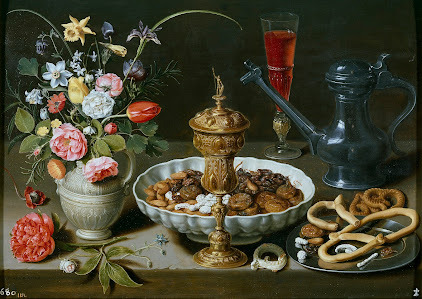 Clara Peeters, Still life with nuts candy and flowers 1611
Clara Peeters, Still life with nuts candy and flowers 1611Rituals of Greeting
This makes a nut a quite generous (but not too generous) gift with which to open negotiations.
Such is the theatre of the Nut; two groups meet beneath the earth. First they scent or hear each other, then see each others light. Each makes signs of peace and the factions approach slowly until the boundary of their lamplight (roughly 30ft) meets.
One from each company is sent forth, each standing directly beneath the lamp-light of the other, proving no ill intent on either side.
Then the lamps are brought together, making a pool of shared and intensified light where the leaders of each group may sit.
Here comes the nut, (if you have one).
"Allow me please, to give a thing never before seen, and once seen, never to be seen again."
Here one displays the nut upon an open palm. The recipient gently takes the nut. Rolls it between their palms, smells it, examines its texture with hand and eye.
"Truly beautiful, a rare and unique gift."
Then the recipient may break open the nut themselves, or hand it over to one stronger of their own side, (which means something, everything said and done in the nut ceremony means something), who breaks it open for them.
The 'secret' is revealed. All present admire this heretofore unseen thing.
The recipient consumes the nut.
It’s a handshake, but a firm one. Those in poverty might offer, at least, a seed. The wealthy might offer meat, (but to offer too much would be to create a debt, almost an aggressive act). An Aelf-Adal Lord might offer a terrifyingly expensive, unique and impractical gift, this is an act of chaotic and charismatic dominance, which creates a link of fealty. Of course you cannot say “no”. A Knotsman might offer exactly what you need, with no immediate price. This is a trap and an attack on you which it may be hard to resist.
A Nut is a pleasingly minor but substantial, yet elegant, gift. It’s hard not to negotiate reasonably and in good faith with someone who has presented you with a nut.
The Veins could not exist and if they did you certainly could not easily 'adventure' through them.
Therefore, in the imagined world, the small cultures of the Veins; tribes, villages and pilgrims, are calmer and more corporate than many of their real-world equivalents might have been. Here are some examples of how this works in play and both diegetic and game-design reasons why this is so.
It’s a war of all against all but not a lawless war of all against all.
There are 'Civilisations' in the volumes, and though their grip is tenuous and vague, it becomes more vital the slighter it becomes. The signs and symbols of power mean less, the closer to its centre one is. Out in the margins, where the power may or may not exist, its signs, symbols and promises become much more important. Exactly which Lord is everyone in fealty too, and which Coagulation do they serve?
People really do not like or want chaos or disorder. It makes it hard to live.
So there are 'Civilised' people who exist largely or nominally under the 'protection' of say a City or a Group, like perhaps they have a Knotsman Contract, and above them perhaps an Aelf-Adal Terror-Lord who rules maybe thousands of nearly-impenetrable kilometres away.
Let’s say the PCs Murder-Hobo a community, take everything they have, then roll into the next Coagulation, or into a Pilgrim People.
These new-encountered people will almost certainly know exactly what the PCs have done. Resources don't come from anywhere and they will recognise whatever has been taken. They were probably well aware of the Group the PCs murderised. They may have even been in conflict with the same group at points.
They will happily trade for these resources, (keeping a close eye and guard on the PCs this whole time). That's just being practical. If there is a real 'evil' in the Veins, it is; wasting resources.
Nevertheless, word will get back. Via Bat and trader, by psychic dream-signal or forgotten hypertechnology, first one group, then another, will discover the PCs reputation. Word will get back to the City, to the Lord, and the Lord must have Order, of a sort, in their realm.
It’s a war of all against all but it can never be allowed to blossom into chaos. There must be some form of retribution, recompense, penance, punishment or service.
The reach of the Lord is long, slow and inconsistent, but memories last down here and nothing the PCs do will be forgotten. And if the Lord is an Aelf-Adal, then their reach pierces darkness, flesh and stone. There is no escape, ever, anywhere.
“I let you share my light.”
No-one has any duty to keep you alive or give you resources.
However, if a deal is to be made, they should at least offer you an acorn of something drinkable, a few seeds worth of food, some light and warmth, at least until you have talked things out.
Of course you will be expected to return this in kind, even if an agreement is not reached.
In 'ideal' circumstances this leads to a cycle of functional giving, starting with letting someone into your circle of light, and ending with a handshake deal for resource exchange.
Even if things don't work out, its considered civilised to give minor gifts equivalent to the cost of the negotiation before you nope out of there.
Just leaving with no exchange at all, really fucks up your reputation.
If you stay with a Tribe, Coagulation or Group, for a period, benefitting from their light, their warmth, their food and presumably their ears listening for you in the dark, it’s a nearly iron law that you exchange with them resources at least equivalent to the cost of keeping you.
This can lead to different groups, say a Tribe of Once-Men and the travel caravan of a RayMan trader, occupying different sides of a river or cavern, their lights kept separate with a measurable stretch of darkness between.
They are not dicking each other over, just being very very careful about not implying any obligation or debt between them. It’s a way of keeping the peace.
Likewise, if one of these groups is attacked in the night, the other may refuse to intervene, and this would not necessarily be taken as an insult or aggressive action. Intervening in someone else’s battle creates a debt and that debt may be hard to carry.
Waiting for a group to nearly-win a fight, then charging in to help them finish it off, will not be taken as a positive helpful act. They had nearly won anyway and your intervention has created a debt they cannot deny but do not wish to suffer. Assume malicious compliance hereafter.
In terms of actually gaming this means Veins populations are actually more 'corporate' minded than many actual populations encountered during, for example, the European Age of Exploration.
A main problem for a Pith-Helmeted European explorer, apart from the environment and massive cultural differences, is simply the number of tribes you have to deal with. Each of these groups will have its own politics, its own relationships with adjacent groups, its own leaders, mood, attitude to foreigners etc etc. Thats twenty, thirty, fifty individual encounters with fifty different tribes with essentially a random generation engine whirring in the background each time, and you (the explorer) can't afford to be taxed that much with each group, and you can't afford for things to spiral out of control even once, or you die.
Empires solve this problem by simply murdering anyone who disagrees and telling whoever is left that yes actually you all live under the same rules now and no you don't get to take individual taxes or even fight each other without permission.
It was easier for a European traveller to move across the whole expanse of Eurasian Islam, (provided they could match the behavioural codes), or across the gigantic steppe empire of the Khans (provided they had the right disc from the Great Khan), than across much of Central Africa (fifty tribes again).
So the Veins are a 'bit' more 'Imperial' than they could reasonably be expected to be. Simply to make it possible to move through them. Though, there are vast areas of 'wilderness stone' where who knows what might happen, as well as disputed areas, actions and polities, reaving borderlands, unexpectedly desperate or shifty populations, general monsters, Olm, and god knows what else.
'Adventure' like 'Exploration' fundamentally requires a boundary between the more-known, more organised, and the lawless unknown. To 'Adventure' is to move back and forth across these zones, usually from a place of law and organisation, into a place with no, or unrecognised law. Resources are gathered from the margins, but they only become resources if there is somewhere else you can take them where their value is renegotiated.

